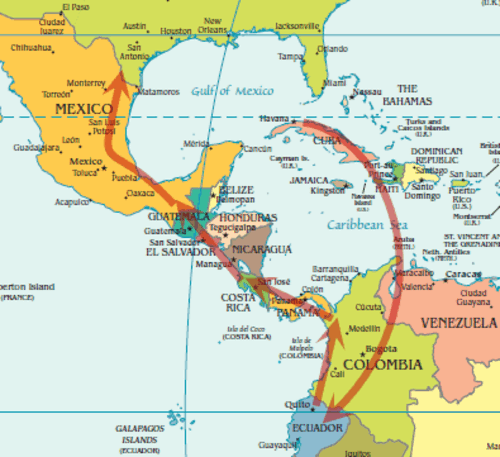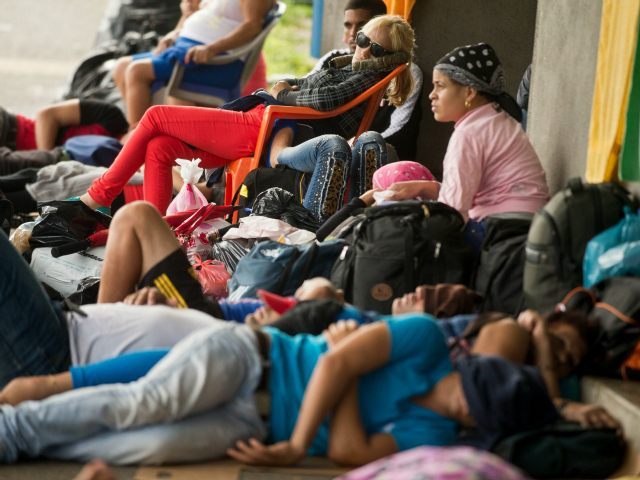This morning’s key headlines from GenerationalDynamics.com
- Central Americans reach agreement on letting Cuban refugees reach the US
- ISIS may be linked to massive suicide bombing in northwest Pakistan
Central Americans reach agreement on letting Cuban refugees reach the US

Route used by Cuban refugees before Nicaragua closed the border: Plane flight to Ecuador, then on foot overland to the US
A meeting of the Central American Integration System (SICA), a political and economic organization for Central American countries, has reached agreement to help thousands of Cuban refugees, stranded in Costa Rica, to reach the United States. The refugees were stranded in Costa Rica after Nicaragua closed the border, refusing to let them pass through.
US law has “wet foot, dry foot” policy with respect to Cuban refugees traveling by boat from Cuba to Florida. According to the 1966 Cuban Adjustment Act, if the US Coast Guard intercepts them before reaching Florida (“wet foot”), then they can be sent back to Cuba. But once they set foot on American soil (“dry foot”), then they are allowed to stay and can apply for asylum after a year.
However, Cuban refugees have found an alternate route that takes advantage of the “wet foot, dry foot” policy — by traveling over land through Central America, through Mexico, then to the United States to apply for asylum.
Cubans who take this alternate route begin by flying to Ecuador, which had no visa requirements for Cubans entering the country. From there they travel on foot overland through Colombia, Panama and Costa Rica to the Nicaraguan border. They then continue on foot through Nicaragua and north, eventually reaching Mexico and then the United States. Once they reach the US, they can apply for asylum.
Few Cuban exiles attempted this route in the past, but the numbers sharply increased since December 2014, when the Obama administration announced the restoration of diplomatic relations, for the first time since the Cuban Revolution of 1960 and the Bay of Pigs invasion of 1961.
Since the restoration of diplomatic relations, many Cubans feared that the US would end the “wet foot, dry foot” policy, and that they would be just like all the other Latin American migrants, treated as illegal immigrants when they enter the US. So Cubans have been rushing to beat any possible change, and the number of refugees has gone as high as 1,000 per week in recent months.
Since Nicaragua closed its border in mid-November, the Cubans have been stranded in Costa Rica. There are now as many as 8,000 Cuban refugees stranded in Costa Rica. SICA has had several meetings since then, asking Nicaragua to provide a “humanitarian corridor” through which the migrants can travel north.
Pope Francis has called for a quick solution:
I invite the countries of the region to renew with generosity all necessary efforts in order to find a rapid solution to this humanitarian drama.
Nicaragua has refused to allow any “humanitarian corridor.” It is believed that the reason is that Nicaragua is a close ally of Cuba, and Cuban authorities have been demanding that the US end the “wet foot, dry foot” policy which has allowed so many Cubans to leave for the United States. A couple of weeks ago, Nicaragua withdrew from SICA membership, rather then be pressured.
So in its Monday meeting, SICA came up with a kind of “plan B”: The migrants will be put in a plane and flown from Costa Rica to El Salvador, where they will then be ferried toward Mexico by bus.
There are still some hitches that have to be worked out. It is not known who will pay for this transportation, and Mexico, which is not a member of SICA, has to sign off on the plan. A pilot program will begin as early as next week, when 250 Cuban refugees will be flown from Costa Rica to El Salvador.
When word spreads that a deal has been reached to bypass Nicaragua, it’s fear that there will be a new surge of Cuban exiles trying to take advantage of the new opening. Prensa Latina and Reuters and BBC
ISIS may be linked to massive suicide bombing in northwest Pakistan
A suicide bomber on Tuesday blew himself up outside a government building in Mardan in northwest Pakistan, near Peshawar. 26 people were killand and dozens wounded. The casualties would have been much higher, but a security guard stopped the suicide bomber from reaching a crowd of 400 people queued up to get papers.
Terrorist group Jamaat ul-Ahrar (JuA, Assembly of Freedom) has claimed responsibility for the bombing. JuA has long been one of the terrorist groups under the umbrella group Tehrik-e-Taliban Pakistan (TTP). JuA split off from TTP in the middle of 2014 in a disagreement caused by TTPs plans to hold peace talks with Pakistan’s government. JuA has rejoined TTP this year, but has also declared allegiance to the so-called Islamic State (IS or ISIS or ISIL or Daesh), which would make Tuesday’s bombing the first major terrorist attack linked to ISIS in Pakistan.
It is thought that JuA perpetrated Tuesday’s attack because it is the one year anniversary of the horrific Taliban attack on a Peshawar army school, killing over 130 schoolchildren, for which JuA is also responsible.
Pakistan’s people over the years have exhibited an accepting attitude towards the Taliban, even when they conducted terror attacks on Pakistani soil. A lot of this acceptance occurs because many of the attacks were on Shias, whom most Pakistanis don’t care about, and many other attacks were against targets in India and Afghanistan of Indians, whom many Pakistanis hate.
However, last year’s Peshawar attack targeted innocent dozens of innocent army schoolchildren, and was so devastating, that many minds were changed. Pakistan’s military stepped up attacks on Taliban targets in Pakistan’s tribal areas, and also began hangings for convicted terrorists. This has infuriated the Taliban, and it’s feared that Tuesday’s terrorist attack was part of a growing spiral of revenge. The News (Pakistan) and Dawn (Pakistan) and VOA
KEYS: Generational Dynamics, Cuba, Ecuador, Costa Rica, Nicaragua, Central American Integration System, SICA, Florida, El Salvador, Wet foot – dry foot, Colombia, Panama, Mexico, Pope Francis, Pakistan, Mardan, Peshawar, Tehrik-e-Taliban, TTP, Pakistan Taliban, Jamaat-ul-Ahrar, JuA, Assembly of Freedom, Islamic State / of Iraq and Syria/Sham/the Levant, IS, ISIS, ISIL, Daesh
Permanent web link to this article
Receive daily World View columns by e-mail

COMMENTS
Please let us know if you're having issues with commenting.